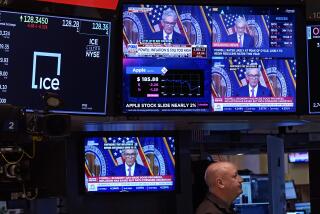Fed Gives Banks Bigger Doses of Liquidity in Black Monday’s Wake
NEW YORK — The Federal Reserve Board has been supplying an extraordinarily high level of liquidity to the nation’s banking system since stock prices collapsed in mid-October, new figures from the central bank indicated Thursday.
The Fed said banks had an average of $1.75 billion in excess reserves on hand each day in the two-week period ended Wednesday. At the same time, bank borrowing from the Fed was relatively low.
Analysts said the net effect is that the Fed appears to be taking sufficient steps to assure that the banking system had enough money on hand to handle any problems caused by the stock market turmoil.
In the same report, the Fed said that its most basic measure of the money supply climbed $9.1 billion in the week ended Oct. 26.
That increase, analysts said, reflected money that people received for selling stock during the market’s collapse or withdrew from mutual funds, converting their investments into cash or putting them in the bank.
Securities Purchases
F. Ward McCarthy, chief financial economist for Merrill Lynch Capital Markets, said the latest bank reserve data “show the Fed has been supplying an enormous amount of liquidity to the banking system.”
The Fed has been supplying reserves almost daily by periodic purchases of large amounts of securities from government bond dealers. The money the dealers receive for their securities usually winds up in the banking system.
In the wake of the price collapse Oct. 19 that saw the Dow Jones industrial average fall 508 points, the Fed reaffirmed that it stood ready to supply liquidity to the banking system, an announcement that is generally credited with having a calming effect on the market.
No Long-Term Effects
In its report, the Fed said M1 climbed to a seasonally adjusted $768.5 billion in the week ended Oct. 26, from a revised 759.4 billion the previous week, initially reported as $759.5 billion.
M1 includes cash in circulation, deposits in checking accounts and non-bank travelers checks.
For the latest 13 weeks, M1 averaged $753.7 billion, a 2.5% seasonally adjusted annual rate of gain from the previous 13 weeks.
William V. Sullivan Jr., director of money market research for Dean Witter Reynolds Inc., said the money supply rise “was clearly a stock market-related phenomenon” that should have no long-term significance for Fed credit policy.
In other reports:
- The Federal Reserve Bank of New York reported commercial and industrial loans at major New York City banks rose $1.1 billion in the week ended Oct. 28, compared to a decline of $604 million the previous week.
- The Federal Reserve said bank borrowings from the Federal Reserve System averaged $254 million a day in the week ended Wednesday, down from $320 million a day in the previous week.
- The Federal Reserve Bank of St. Louis reported that the monetary base, the seasonally adjusted total of member bank reserves held at Federal Reserve banks and cash in bank vaults and in circulation, was $272.5 billion in the two-week period ended Wednesday, up from $268.0 billion two weeks earlier.
More to Read
Inside the business of entertainment
The Wide Shot brings you news, analysis and insights on everything from streaming wars to production — and what it all means for the future.
You may occasionally receive promotional content from the Los Angeles Times.










